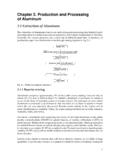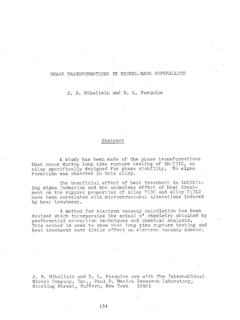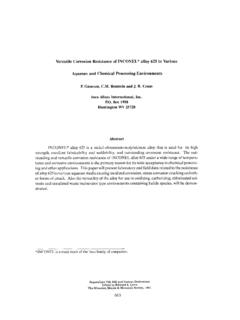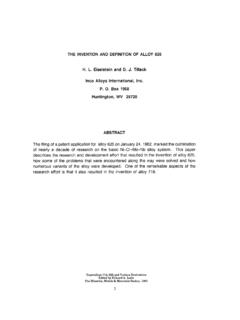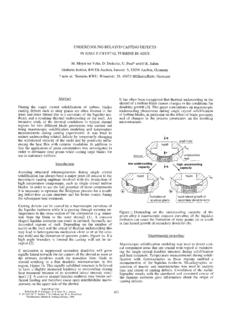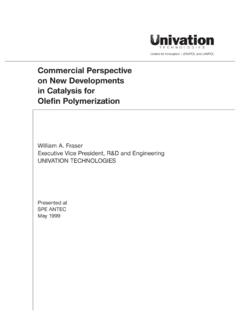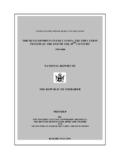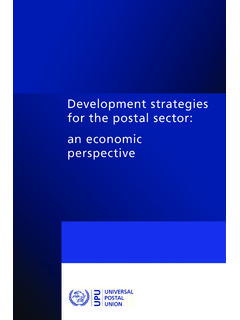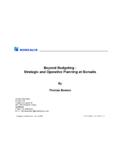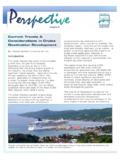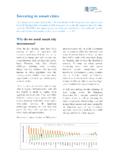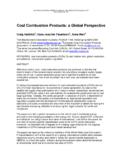Transcription of Alloy 718 at Pratt & Whitney – Historical Perspective and ...
1 Alloy 718 AT Pratt & Whitney - Historical Perspective AND FUTURE CHALLENGES Daniel F. Paulonis and John J. Schirra Pratt & Whitney , United Technologies East Hartford, Connecticut Abstract The introduction of Alloy 71 8 at P&W in the early 1960's represented a significant advance in gas turbine engine technology, enabling the manufacture of engines with lower cost, lighter weight and simplified construction. This paper traces the applications and evolution of this unique material over the last four decades at P&W, along with some of the reasons for its introduction. From its initial use in 1963 for the diffuser case of the 558 engine for the SR-71 Blackbird, the Alloy is now the most widely used of all nickel alloys at P&W. Applications include disks, cases, shafts, blades, stators, seals, supports, tubes and fasteners. Some of the key studies conducted at P&W to increase our understanding of the Alloy and to improve its properties, uniformity and quality are also described.
2 Additional challenges remain, however, if we are to exploit this Alloy system even further into the 21St century. Most notable among these include a need for improved understanding and process models to allow us to tailor properties to specific applications, and the development of a higher temperature derivative. An Alloy is needed which would retain all of the property, cost and fabricability advantages of 718, but with greater resistance to overaging to allow a 50-100F (28-56C) increase in use temperature. Supcrnllo) s 7 18. 625. 706 ;mi1 \'arious Dcrivati\.es Eclitcti b> E .\, Loria rhlS (The hlinernls. lletals & hlaterials Society). 2001 13 Introduction Alloy 718 is the most widely used nickel Alloy at P&W, accounting for over 50% of the superalloy content in some engines. And what an extraordinary material it is! H. Eiselstein's I INCO's gift to us (1) revolutionized many aspects of gas turbine engine design, and enabled these engines to be made at significantly lower cost, less weight and with simplified construction.
3 Furthermore, it also allowed increased design flexibility for improved performance (and understanding its complex behavior has proven to be fertile ground for the fmits of many materials engineering careers). The combination of Alloy 718's unique property balance, its ability to be processed as both wrought and cast products, and its weldability made it a natural candidate material for many gas turbine applications. Within only a few years of the initial announcement of lN718, P&W began to issue specifications and selected the material for critical applications. Most of the initial applications were on military engines (558, TF30 and FlOO), but from the late 1960's through the 1980's, commercial engine applications grew rapidly (JT9D, PW2000 and PW4000). Working closely with the supply base, P&W contributed to improvements in material quality and capability, primarily through process optimization to refine grain structure and reduce segregatioddefects.
4 Some of the later applications of this Alloy at P&W include several components in the very critical high-pressure turbopump of the Space Shuttle Main Engine (SSME), which first flew in 1995. Key milestones related to the incorporation of Alloy 71 8 at P&W are shown in Figure 1. Figure 1. Key specification and application milestones related to the incorporation of Alloy 718 at P&W. The Early Years - Initial Applications and Increased Understanding Soon after the Huntington Alloys Division of INCO announced IN718 in 1959, P&W recognized its unique combination of attributes: high strength, weldability and fabricability. P&W conducted its own preliminary assessment and in March of 1962, issued its first series of material specifications that covered bar, forgings, sheet and weld wire, all from vacuum melted materials. Issuance of these specifications was hastened since there was a critical need at this time for Alloy 718 to support P&W's initial application, a complex welded diffuser case structure for the JTll (eventually to become the 558) engine for the SR-71 Blackbird surveillance and reconnaissance aircraft (Figure 2).
5 L Figure 2. First critical application of Alloy 71 8 at Pratt & . welded diffuser case in the 558 engine for the SR-71 Blackbird. Development of the JTll for this supersonic (greater than Mach 3) aircraft began in the late 1950's. Because of the SR- 71 's speed, most of the engine operated at temperatures well in excess of 1000 F (538C). Therefore the engine was initially made almost entirely of Waspaloy (one of the strongest materials at that time). In Waspaloy, the difhser case welds were very prone to strain-age cracking, making it extremely difficult to produce a satisfactory part. Switching to Alloy 718 provided the answer. This initial success was soon followed by many other applications for wrought Alloy 71 8, including: TF30 (-1965) - Fabricated Turbine Exhaust Case and stator assemblies F 100 (- 197 1) - Variable vanes, stators, cases JT9D (-1968) - Fabricated Diffuser Case ---First major application of Alloy 718 in a commercial P&W engine The 718 material produced in these early days could not meet today's high quality standards.
6 Vacuum processing was still in its infancy, and Alloy 718, with its high Nb content, was intrinsically difficult to melt without segregation or melt defects. Hence, this early material was characterized by significantly less uniformity than today's product, and the supply base pushed back on some of P&W's initial requirements for fine grain size. Another concern at this time was 718's tendency for notch sensitivity. Through work conducted at P&W and elsewhere, it became recognized that some amount of delta phase is needed at the grain boundaries to avoid notch brittleness, and this knowledge provided the basis for P&W's solution temperature requirements. Throughout its first decade of use, only minor revisions were made to P&W's wrought 71 8 specification (PWA 1010): Relaxation of grain size requirement from ASTM 6 to 4 Clarification of the solution heat treatment temperature Slight reduction in minimum allowable ductility levels.
7 P&W7s first casting specification (PWA 649) was issued in 1965. Initially, only relatively small investment cast parts and details such as diffuser case and instrumentation bosses were produced. P&W's first application for a relatively complex Alloy 718 structural casting was the turbine exhaust case in the TF30 (-1969). This single casting replaced a welded assembly comprised of 38 individual details (Figure 3 j, resulting in significant cost savings. In this same time period, an effort was made to replace the wrought diffuser case assembly in the JT9D, with a single part proved to be a challenge beyond the capability of the industry. The cause for this program's lack of success was directly attributed to marginal casting quality regarding grain variation and soundness., porosity. Thus a cast case would have had higher then anticipated weights and lower then expected cost savings compared to the established wrought case.)
8 The previously mentioned TF30 case was successful since it was a simpler part to cast and had less demanding LCF requirements. piece casting. The goal was to achieve significant cost savings at the expense of added weight resulting from lower cast properties. However, this significantly larger and more complex During this initial decade of Alloy 718's commercialization, P&W and others were able to take advantage of its unique properties without having a very good understanding of its strengthening mechanisms. Recognizing this need in the late 1960's, P&W conducted detailed I F 1 l-rt % ii /I -3 t . Wrought case Cast case 38 deta~ls I &tall Figure 3. First large Alloy 71 8 structural casting at P& .. TF30 Turbine Exhaust Case. One casting replaced assembly of 38 parts. studies to understand both the details of precipitation and strengthening mechanisms in allc 71 8. It was known that the Alloy had unus;allyAhigh strength for having a relatively low volume fraction of precipitate, as well as very slow precipitation kinetics compared to yr-strengthened alloys such as IN90 1, Waspaloy and Rene 41 (a key contributor to its excellent weldability).
9 Even though the Alloy had been in existence for almost ten years, uncertainty remained about the exact nature of its strengthening precipitates. Utilizing dark field transmission microscopy, a relatively new technique, it was unequivocally shown that a body centered tetragonal phase, yfr, is the primary - - Figure 4. Dark field transmission micrographs showing three variants of Y" and a bright field rapidly above 1200F (649C), resulting in overaging and loss of strength. It was also demonstrated that the exceptional strength of Alloy 71 8 was due to the high coherency strains associated with y" (3). strengthening phase (Figure 4), although some yr is The Next Several Decades - Process Improvements and Expanding Applications - .+ image showing high coherkncy strains By 1970, it was clear that Alloy 718 was going to play an increasingly important role in gas turbine engine development at P&W. It was also becoming evident that this Alloy was more complex than conventional yr-strengthened superalloys and required additional process development to enable P&W and others to fully exploit its potential.
10 Over the next several decades, P&W built on its studies of the 60s and tapped into the significant developments generated by the metals industry and other aerospace companies regarding process optimization of Alloy 718. In general the goal was to optimize process parameters to enhance the Alloy 's property balance and reproducibility. Major achievements included advances in also present (2). y" was shown to coarsen relatively ingot melting methods that dramatically improved cleanliness, minimized ingot defects such as freckles, and in general reduced segregation, enabling the casting of larger diameter ingots. Combined with improvements in billet conversion and forging methods leading to finer grain products and improved sonic inspectability, these developments resulted in an accelerated rate of application of the Alloy into more critical engine components. Wrought Alloy 71 8 was widely becoming accepted as the low cost, high capability material of choice at P&W for many static and fabricatedlwelded components.

